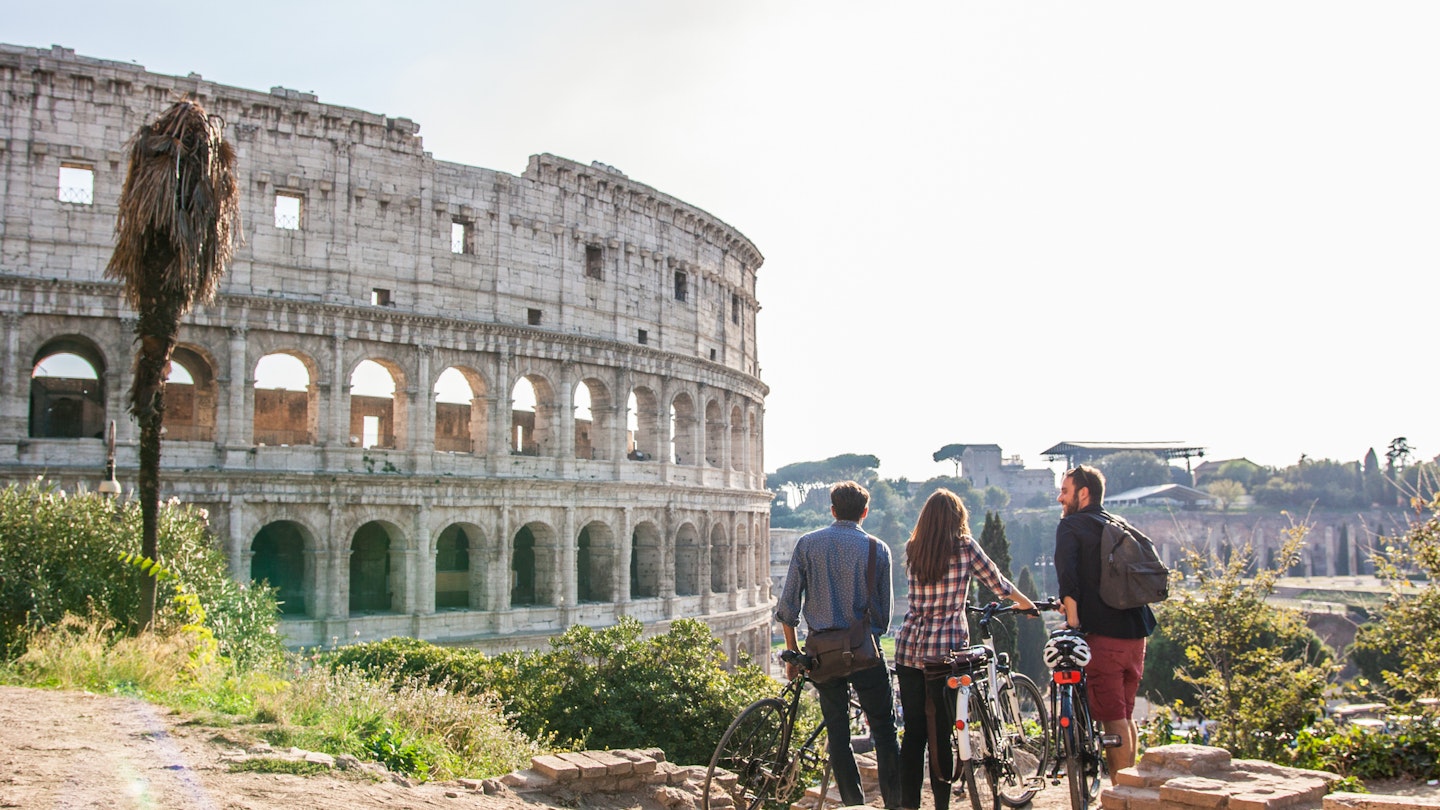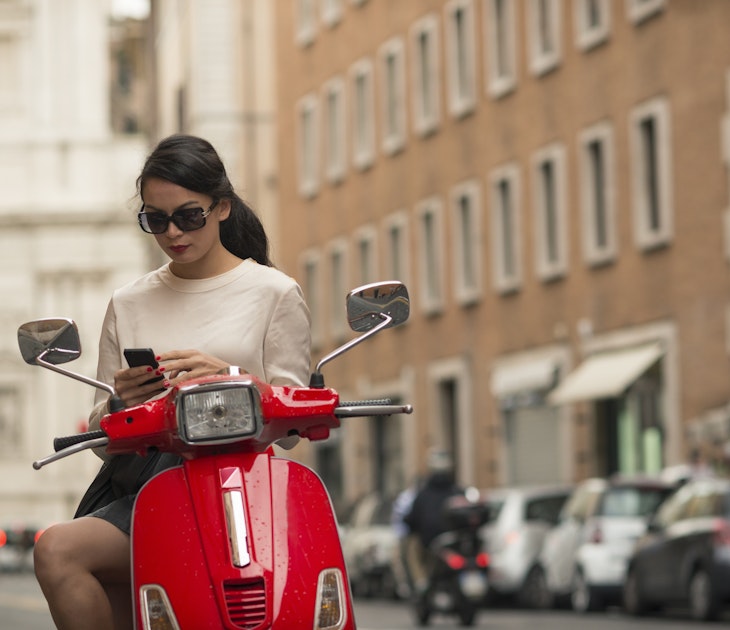Whether or not you find it easy to get around Rome will depend a lot on what your expectations are.
The most important thing to remember is that Rome is old. Like, old. Most of the streets have not been designed to accommodate people, buses, cars or bikes, and the underground network has been built in and around one of the most archaeologically rich locations on earth. The very things we all come to Rome to see are the very reason that it takes so long to get around it. Keep that in mind the next time you visit and remember that any confusing detours you go on may end up being the best part of your trip!
Here's what you need to know to find your way around in Rome.
Explore the city on mass transit
Just like any major city, the Eternal One has a comprehensive public transport network of buses, trams, and trains that will take you anywhere you want to go. Of course, they may also take you to a few places you weren’t planning on visiting, so it helps to get yourself familiarized before you’re on the ground. Atac, the company that operates all mass transit in Rome, has undergone a facelift in recent years and though some wrinkles are still visible, it’s a pretty convincing nip and tuck. Visitors can download maps in multiple languages from the Atac website, or download the Moovit app to get real-time info.

Metro line C is best for sightseeing
It’s helpful to remember that the two metro lines A and B mostly travel north and south, with the C line heading further to the east. The C will be one of the most familiar sights if you pass through central Rome: archaeological finds at the Imperial Forum station are so proliferate that it’s taken decades to dig for tracks. As a result, the street between the Colosseum and the Forum is lined with heavy machinery and the promise that “it’ll soon be done.” Don’t hold your breath, but don’t sweat it either, and remember that the street is still open to some traffic, so be mindful when crossing the road.
Trams run east to west
Rome’s six small tram lines are primarily useful for traveling east to west and are a good way to see the Trastevere and Monteverde neighborhoods. The trams are a fun, somewhat nostalgic, slightly nicer way to travel as they tend to avoid a lot of the car traffic. Plus, some vintage trams are still in operation, so may get the chance to catch a bit of retro cool as you go.
The tram system plays an important role in the history of modern Rome and it’s worth getting to know a bit of the background (for all of our transit history fans out there). However, an ongoing improvement project on the number 3 tram line means that you’ll need to take a bus replacement service if you want to get across the Tiber, so some of the convenience, and thus the charm of the trams, might escape you.

Rome's bus network is extensive
But consider that replacement bus service a good way to dip your toe in the vast bus network, which covers the most ground of any part of Rome’s mass transit system. Riding the bus is one of the best ways to immerse yourself in the cacophony of the city and though the sheer size of the network might feel intimidating, it’s worth doing.
The Atac signage at almost every bus stop can help you go in the right direction, and the Moovit app has up-to-the-minute timetables that will tell you which direction to look. And as always, don’t be afraid to ask people waiting at the same stop: you may get a few grumbles but you’re much more likely to get someone who will not only tell you whether you’re in the right place but will also make sure you actually get on the right bus.
Tickets are valid on buses, trams and metro lines
Travelers can purchase daily or weekly farecards from machines or kiosks located at the entrance to nearly every metro station, and the Tap and Go system is available to anyone with a contactless card as well as smartphones and smartwatches. You’ll be charged for single rides and each is valid for 100 minutes, as with a standard travel card. While the Tap and Go system has become quite reliable in the past year, it still has its share of hiccups and is occasionally out of service for maintenance. It doesn’t hurt to have a ticket in reserve for just such an occasion. Oh and, the ticket machines don’t give more than €6 in change so be aware before you use a €20 note to pay for a €1.50 ticket!

Walking is the best way to see some of Rome's key sites
Walking through Rome is as frenetic and romantic as you think it will be, and you’ll see icons at every turn. Much of the ancient center of Rome, which includes sites like the the Colosseum, the Forum and the Pantheon, is easily within walking distance, and on a nice day, you could cover all of these and much more.
There is always something going on and if you slow down a bit, you’ll find yourself soaking up the ambiance that makes Rome so singular. After all, it’s only by walking that you’d catch the Rose Garden hiding above the Circo Massimo, or the path that winds along the Tiber River. If you want to see Rome for what it truly can be, stop and walk for a while.
Of course, for all its magic, the center of Rome can be extraordinarily congested with foot and car traffic, so navigating these areas sometimes takes a lot of time and even more patience.
Try to avoid peak hours at places that you’re not necessarily going to enter: if you only want to walk around the Colosseum, wait until after it closes at 6pm and the crowds largely dissipate. After all, that’s the magic hour, when the light hits it just right and everything is illuminated with pink and gold hues.
Driving in Rome is best avoided
Here’s the thing. Driving in Italy is an art form, and if you can drive in cities like Rome, you've reached a new level of mastery. Romans drive with an urgency and a logic that will escape everyone else, and while it may seem that they’re aggressive (and they can be) often they’re just moving into openings in traffic that only they can see. Do not attempt to mix in this, as it will inevitably result in confusion on your part and frustration on the part of everyone around you.
Taxis are easy to find
Leave the driving to the professionals, in this case the Romans. Taxis are proliferate, and can be easily ordered via the Free Now app, which will give you fixed rates and allows you to pay through it as well. Uber is also quite reliable around the city and will give you the option of both a taxi or private hire car called an NCC, which stands for Noleggio con Conducente (hire car with driver).
Bikes and scooters are popular, but not always wise
Exercise caution with bikes and scooters in Rome. These have become a popular mode of transportation here just as in other cities around the world. Tours guides are often skilled at helping riders navigate the streets on bikes and scooters, but if you’re not used to riding in busy lanes with uneven sidewalks, you could put yourself (and others) at risk.
Rome is not very accessible
Both the national and municipal governments have been working on improving the city’s infrastructure for people with disabilities, and the ATAC website offers a comprehensive overview of the metro, tram, train and bus services for people with disabilities. According to the ATAC website, 98% of buses are equipped with boarding platforms, 70% of trams have platform level flooring, and the vast majority of metro stations have elevators as well as tactile paths and maps for visually impaired passengers, displays for those with hearing impairments, and Braille messaging. The website also has a handy search function to check whether your station has these services available, and is updated in real time for any service interruptions.
Major sites around the city offer special access to visitors with limited mobility: it’s possible to reserve a wheelchair at the Vatican museums, and the Colosseum has both ramps and elevators to facilitate movement around the monument (that said, the underground parts of the Colosseum are not wheelchair accessible). But there’s no doubt that it’s still slow going on those picturesque cobblestone streets for those with any mobility challenges, including those who might be traveling with small children and strollers. Keep it in mind as you plan your day, and if you’ve got precious cargo in hand try to schedule your iconic visits for off peak hours.












